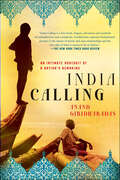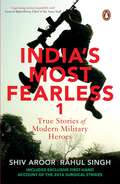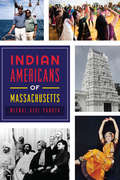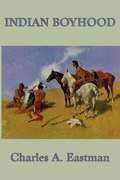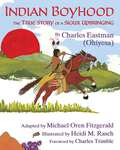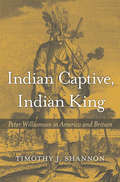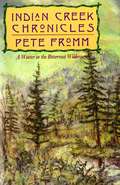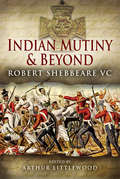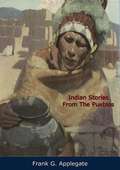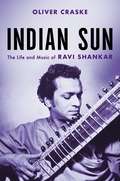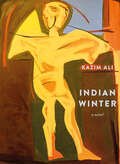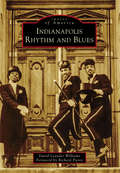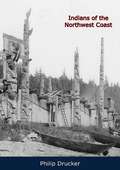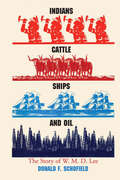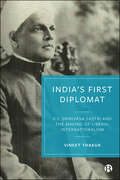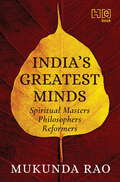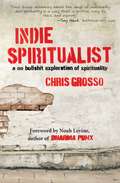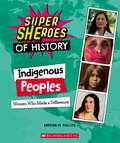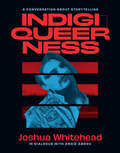- Table View
- List View
India Calling: An Intimate Portrait of a Nation's Remaking
by Anand GiridharadasReversing his parents’ immigrant path, a young American-born writer returns to India and discovers an old country making itself new.Anand Giridharadas sensed something was afoot as his plane from America prepared to land in Bombay. An elderly passenger looked at him and said, “We’re all trying to go that way,” pointing to the rear. “You, you’re going this way?” Giridharadas was returning to the land of his ancestors, amid an unlikely economic boom. But he was more interested in India’s cultural upheaval, as a new generation has sought to reconcile old traditions and customs with new ambitions and dreams.In India Calling, Giridharadas brings to life the people and the dilemmas of India today, through the prism of his émigré family history, introducing us to entrepreneurs, radicals, industrialists, and religious seekers, and, most of all, to Indian families. Through their stories, and his own, he paints an intimate portrait of a country becoming modern while striving to remain itself.Praise for India Calling“A fine book, elegant, self-aware and unafraid of contradictions and complexity. Giridharadas captures fundamental changes in the nature of family and class relationships and the very idea of what it means to be an Indian.” —The New York Times Book Review“[A] smart, evocative and sharply observed memoir . . . Giridharadas’s narrative gusto makes the familiar fresh.” —The Wall Street Journal“[A] readable, intriguing book . . . [Giridharadas is] a marvelous journalist—intrepid, easy to like, curious . . . India Calling connects us to a new India, and an engaging new voice.” —The Plain Dealer (Cleveland)
India and the Quest for One World
by Manu BhagavanIndia and the Quest for One World revolutionizes the history of human rights, with dramatic impact on some of the most contentious debates of our time, by capturing the exceptional efforts of Mahatma Gandhi and the Nehrus to counter the divisions of the Cold War with an uplifting new vision of justice built on the principle of "unity in diversity. "
India's Most Fearless True Stories of Modern Military Heroes: True Stories Of Modern Military Heroes
by Rahul Singh Shiv AroorThe Army major who led the legendary September 2016 surgical strikes on terror launch pads across the LoC; a soldier who killed 11 terrorists in 10 days; a Navy officer who sailed into a treacherous port to rescue hundreds from an exploding war; a bleeding Air Force pilot who found himself flying a jet that had become a screaming fireball . . . Their own accounts, or of those who were with them in their final moments. India's Most Fearless covers fourteen true stories of extraordinary courage and fearlessness, providing a glimpse into the kind of heroism our soldiers display in unthinkably hostile conditions and under grave provocation.
Indian Americans of Massachusetts (American Heritage)
by Meenal Atul PandyaIndians are the most recent immigrants in Massachusetts. Though a tiny minority, their contributions are numerous and far-reaching. Swami Vivekananda arrived in Boston in 1893 and left a lasting legacy of Hindu philosophy. Sushil Tuli opened a unique community bank, Leader Bank, as the first and only minority-owned bank in the state of Massachusetts. The Deshpande Center for Technological Innovation at MIT, created with the grant of $20 million by Desh and Jaishree Deshpande, empowers MIT's researchers to make a difference in the world by developing innovative technologies. Author Meenal Atul Pandya details the influence of Indians on Massachusetts history.
Indian Boyhood
by Charles A. EastmanThe Memoirs of an Indian Boyhood is an autobiography by Charles Eastman. Eastman was a Native American physician, writer, national lecturer, and reformer. He was of Santee Sioux and Anglo-American ancestry. Active in politics and issues on American Indian rights, he worked to improve the lives of youths and founded 32 Native American chapters of the Young Men's Christian Association (YMCA). He also helped found the Boy Scouts of America. He is considered the first Native American author to write American history from the native point of view.
Indian Boyhood: The True Story of a Sioux Upbringing
by Charles Alexander EastmanImagine a childhood full of adventure. Where riding horses, playing in the woods, and hunting for food was part of everyday life; where a grizzly bear, a raccoon, or a squirrel was your favorite pet. But imagine, too, being an orphan at the age of six, being forced off your land by U.S. soldiers, and often going hungry. Such was the childhood of the first great American Indian author, Charles Eastman, or Ohiyesa (1858-1939).Carefully edited for a younger audience by multiple award-winning author and editor, Michael Oren Fitzgerald, Indian Boyhood recalls Eastman&’s earliest childhood memories. He was born in a buffalo hide tipi in western Minnesota, and raised in the traditional Dakota Sioux manner until he was fifteen years old. He was then transplanted into the &“white man&’s&” world. Educated at Dartmouth College, he went on to become a medical doctor, renowned author, field secretary for the YMCA, and a spokesman for American Indians. Eastman was at Pine Ridge during the &“Ghost Dance&” rebellion of 1890-91, and he cared for the wounded Indians after the massacre at Wounded Knee. In 1910 he began his long association with the Boy Scouts of America, helping Ernest Thompson Seton establish the organization. A 2007 HBO film, entitled Bury My Heart at Wounded Knee, features American Indian actor Adam Beach as Eastman.
Indian Business Women: इंडियन बिझनेस वूमैन
by Suman Vajpayeeप्रस्तुत पुस्तक में उद्यम-जगत् में अपना वर्चस्व कायम कर चुकी कुछ महिलाओं की निजी व प्रोफेशनल जिंदगी की प्रेरक घटनाओं का विवेचन किया गया है। इन महिलाओं का जीवन, सोच एवं मेहनत प्रेरणाप्रद है और इससे नई पीढ़ी को बहुत कुछ सीखने को मिलेगा। स्त्री-शक्ति को सही मायने में उद्घाटित करती नारी का सम्मान बढ़ानेवाली लोकप्रिय पुस्तक।
Indian Captive, Indian King: Peter Williamson in America and Britain
by Timothy J. ShannonIn 1758 Peter Williamson, dressed as an Indian, peddled a tale in Scotland about being kidnapped as a young boy, sold into slavery and servitude, captured by Indians, and made a prisoner of war. Separating fact from fiction, Timothy Shannon illuminates the curiosity about America among working-class people on the margins of empire.
Indian Creek Chronicles: A Winter in the Bitterroot Wilderness
by Pete Fromm"The wardens climbed into their truck, ready to leave. 'You'll need about seven cords of firewood. Concentrate on that. You'll have to get it all in before the snow grounds your truck.'" "Though I didn't want to ask, it seemed important. 'What's a cord?'" So begins Pete Fromm's seven winter months alone in a tent in the Selway-Bitterroot Wilderness guarding salmon eggs. After blundering into this forbidding errand as a college lark, Fromm gradually come face to face with the blunt realities of life as a contemporary mountain man. Brutal cold, isolation, and fearful risks balance against the satisfaction of living a unique existence in modern America. This award-winning narrative is a gripping story of adventure, a rousing tale of self-sufficiency, and modern-day Walden. From either perspective, Fromm lives up to his reputation as one of the West's strongest new voices.
Indian Mutiny and Beyond: Robert Shebbeare VC
by Arthur Littlewood"Robert Shebbeare went out as a cadet to India at the age of seventeen and after a spell of ordinary regimental duties, he was caught up in the extraordinary and bloody events of the Indian Mutiny.With fellow officers he managed to escape to Delhi, where he was attached to the Guides, and he took part in most of the action during the long hot summer of 1857. He was wounded six times and was awarded the Victoria Cross for his gallantry during the storming of the city on September 14th. He raised a new regiment, the 15th Punjab, which volunteered for service in China and took part in the advance on Peking in 1860.Tragically, he died en route for England, his family, who had not seen him since he had left 16 years earlier, were all at the quayside to welcome him, unaware that he had been buried at sea.His story is told in his own words from the recently discovered letters which he sent home to his family between 1844–1860. The Editor has provided a commentary that puts the letters into context for the general reader and military historians. "
Indian Stories From The Pueblos: Tales Of New Mexico And Arizona (Beautiful Rio Grande Classics Ser.)
by Frank G. ApplegateIndian Stories from the Pueblos is a combination of tales of early Pueblo days and stories from 1929, when the book was first published. They were written by Frank Applegate, a New Mexican artist who lived among the Pueblos.Contains beautiful illustrations from original Pueblo Indian paintings and a foreword by Witter Bynner.
Indian Sun: The Life and Music of Ravi Shankar
by Oliver CraskeThe definitive biography of Ravi Shankar, one of the most influential musicians and composers of the twentieth century, told with the cooperation of his estate, family, and friendsFor over eight decades, Ravi Shankar was India's greatest cultural ambassador. He was a groundbreaking performer and composer of Indian classical music, who brought the music and rich culture of India to the world's leading concert halls and festivals, charting the map for those who followed in his footsteps. Renowned for playing Monterey Pop, Woodstock, and the Concert for Bangladesh--and for teaching George Harrison of The Beatles how to play the sitar--Shankar reshaped the musical landscape of the 1960s across pop, jazz, and classical music, and composed unforgettable scores for movies like Pather Panchali and Gandhi.In Indian Sun: The Life and Music of Ravi Shankar, writer Oliver Craske presents readers with the first full portrait of this legendary figure, revealing the personal and professional story of a musician who influenced--and continues to influence--countless artists. Craske paints a vivid picture of a captivating, restless workaholic--from his lonely and traumatic childhood in Varanasi to his youthful stardom in his brother's dance troupe, from his intensive study of the sitar to his revival of India's national music scene. Shankar's musical influence spread across both genres and generations, and he developed close friendships with John Coltrane, Philip Glass, Yehudi Menuhin, George Harrison, and Benjamin Britten, among many others. For ninety-two years, Shankar lived an endlessly colorful and creative life, a life defined by musical, emotional, and spiritual quests--and his legacy lives on.Benefiting from unprecedented access to Shankar's archives, and drawing on new interviews with over 130 subjects--including his second wife and both of his daughters, Norah Jones and Anoushka Shankar--Indian Sun gives readers unparalleled insight into a man who transformed modern music as we know it today.
Indian Winter
by Kazim AliCBC BOOKS: 2024 SPRING FICTION PREVIEWA queer writer travelling through India can't escape the regrets of his past, nor the impending ruin of his present. "I am leaving for the winter – I have to get away from this small town and all its dangers – to write, read, think, all the most important things in the world but which are thought the least important, the most expendable."Thus begins the Indian winter of our narrator, a queer writer and translator much like the author, a winter that includes a meandering journey through India, trying to write about a long-ago lover whose death he has just learned of. While on this journey into memory, he flees his current faltering relationship in search of new friendships and intimacies. Inspired by Antonio Tabucchi's Indian Nocturne, and by the writings of Anaïs Nin, Rachel Cusk, and Carole Maso, among others, Indian Winter finds itself where the travel diary, the künstlerroman, poetry, and autofiction meet. But the heartbreak brought on by his unravelling relationship and his family's inability to accept his queerness cannot be outrun; as he traverses India, our narrator can't help but repeatedly encounter himself and the range of love and alienation he has within.
Indiana Originals: Hoosier Heroes & Heroines
by Ray E. BoomhowerHoosier history overflows with bold visionaries, noble heroes and lovable rogues. May Wright Sewall struggled to uplift womankind and unflinchingly called for peace in a world sleepwalking toward conflict. In the guise of Abe Martin, Kin Hubbard graced the Indianapolis News's back page for twenty-six years with folksy humor. Combat photographer John A. Bushemi bravely faced the terrors of war and perished capturing its violence. Audacious automotive pioneer Carl G. Fisher went to any length to promote himself, even flying a car via a hot-air balloon. Drawing on more than thirty years of experience, author Ray E. Boomhower, the dean of Hoosier biographers, brings together forty of the most notable figures from the nineteenth state.
Indianapolis Rhythm and Blues (Images of America)
by David Leander WilliamsIndiana Avenue was traditionally the host to some of America's premier, world-renown entertainment icons in various genres. Along this winding, brightly lit thoroughfare were nightclubs, lounges, supper clubs, taverns, juke joints, and holes-in-the-wall that celebrated the best of the best in entertainment that America had to offer, from the 1920s on into the 1970s. On the bandstand at Denver Ferguson's Sunset Terrace Ballroom, the elegantly attired crooner Nat King Cole, in a sparkling blue silk suit, delivered his signature song "Mona Lisa." Nearby, B.B. King sang his 1973 down-home blues classic "To Know You is to Love You." At Tuffy Mitchell's Pink Poodle nightclub, "Moms" Mabley made the audience roar with laughter during her sidesplitting comedy routine. Indiana Avenue truly was the place to be for the best in entertainment.
Indians of the Northwest Coast
by Philip DruckerWritten by an outstanding authority and profusely illustrated, this is a comprehensive study of the Indians that lived from Yakutat Bay in Alaska to the northern coast of California. Originally published in the Anthropological Handbooks Series of The American Museum of Natural History, this volume vividly recreates the complexities and attainments of this unique culture of aboriginal America.The author first describes the land, people, and prehistory of the area and then considers each aspect of the culture: social structures and marriage customs, economy and technology, religion, rituals, art, wars, and feuds.Philip Drucker, an authority on the ethnology of the Pacific Coast, was educated at the University of California and was formerly with the Bureau of American Ethnology of The Smithsonian Institution in Washington, D.C.Illustrated with over 70 drawings
Indians, Cattle, Ships, and Oil: The Story of W. M. D. Lee
by Donald F. SchofieldIndian trader, rancher, harbor developer, oil impresario—these are the many worlds of one of the least chronicled but most fascinating characters of the American West. In the early, bustling years of the frontier, a brazen young man named William McDole Lee moved from Wisconsin to Kansas and then to Texas to forge a life for himself. Becoming a driving entrepreneurial force in Texas's development, Lee soon garnered the alliances and resources necessary to shape the financial destinies of disparate groups throughout the state. His story is expertly told in Donald F. Schofield's Indians, Cattle, Ships, and Oil. Beginning in 1869 as a trader to the southern Cheyenne and Arapaho tribes and fort provisioner to troops garrisoned at Camp Supply, Indian Territory, Lee gained a partner and amassed a fortune in short order from trading buffalo hides and robes. Vast herds of buffalo grazing on the southern plains were killed largely on his order. When buffalo were no longer a profitable commodity, Lee tackled his next challenge—the cattle trade. He began with herds branded LR that grazed on pastures near Fort Supply. Then came his LE herd in the Texas Panhandle. Another partnership, with noted cattle rancher Lucien Scott, resulted in the vast LS ranch, one of the most successful operations of its day. Lee even introduced a new breed of cattle, the Aberdeen-Angus, to the western range. But as his partnership faded, Lee moved on to his next undertaking—the development of Texas' first deep-water harbor. In 1888, Lee and other financiers put up one million dollars to finance a dream: opening international trade from the waters of the Gulf of Mexico to the mainland at the mouth of the Brazos River. Their Brazos River Channel and Dock Company was to construct, own, and operate a deep-water harbor at Velasco, with a railroad link to Houston. Though threats of financial disaster loomed large, the Velasco facility was to welcome, in its day, tugs, barges, and three-masted schooners and to provide impetus for Houston's boom. Yet with success, the mercurial Lee turned to yet another challenge—oil. Starting still another partnership, Lee committed himself to prospecting for oil on the West Columbia Ridge in Brazoria County. Lee and crew struck oil in 1907, developing one of the first producing wells of Brazoria County, but inadequate drilling equipment hampered further fruitful exploration. Lee moved his rigs to the famed Spindletop, where he perfected the technique of shallow drilling. Though spectacular success in the oil business eluded him, Lee's accomplishments set him squarely among the great entrepreneurs of the Texas oil industry. Lee's exploits led him to roles in some of the most dramatic moments in Texas and the West—Indian uprisings, buffalo hunts, political scandals, cowboy strikes and shoot-outs, railroad promotions, oil-well blow-outs and gushers. The people he encountered are the famous and infamous of western history: Cheyenne Chief Little Robe and the outlaw "Hurricane Bill" Martin; Indian Agent John D. Miles and Major General John Pope; outlaws Tom Harris and William Bonney, and Sheriff Pat Garrett. Altogether, Lee's biography vividly shows one man's manipulation of people and events during the settlement of the American frontier.
Indians, Cattle, Ships, and Oil: The Story of W. M. D. Lee
by Donald F. SchofieldIndian trader, rancher, harbor developer, oil impresario—these are the many worlds of one of the least chronicled but most fascinating characters of the American West. In the early, bustling years of the frontier, a brazen young man named William McDole Lee moved from Wisconsin to Kansas and then to Texas to forge a life for himself. Becoming a driving entrepreneurial force in Texas's development, Lee soon garnered the alliances and resources necessary to shape the financial destinies of disparate groups throughout the state. His story is expertly told in Donald F. Schofield's Indians, Cattle, Ships, and Oil. Beginning in 1869 as a trader to the southern Cheyenne and Arapaho tribes and fort provisioner to troops garrisoned at Camp Supply, Indian Territory, Lee gained a partner and amassed a fortune in short order from trading buffalo hides and robes. Vast herds of buffalo grazing on the southern plains were killed largely on his order. When buffalo were no longer a profitable commodity, Lee tackled his next challenge—the cattle trade. He began with herds branded LR that grazed on pastures near Fort Supply. Then came his LE herd in the Texas Panhandle. Another partnership, with noted cattle rancher Lucien Scott, resulted in the vast LS ranch, one of the most successful operations of its day. Lee even introduced a new breed of cattle, the Aberdeen-Angus, to the western range. But as his partnership faded, Lee moved on to his next undertaking—the development of Texas' first deep-water harbor. In 1888, Lee and other financiers put up one million dollars to finance a dream: opening international trade from the waters of the Gulf of Mexico to the mainland at the mouth of the Brazos River. Their Brazos River Channel and Dock Company was to construct, own, and operate a deep-water harbor at Velasco, with a railroad link to Houston. Though threats of financial disaster loomed large, the Velasco facility was to welcome, in its day, tugs, barges, and three-masted schooners and to provide impetus for Houston's boom. Yet with success, the mercurial Lee turned to yet another challenge—oil. Starting still another partnership, Lee committed himself to prospecting for oil on the West Columbia Ridge in Brazoria County. Lee and crew struck oil in 1907, developing one of the first producing wells of Brazoria County, but inadequate drilling equipment hampered further fruitful exploration. Lee moved his rigs to the famed Spindletop, where he perfected the technique of shallow drilling. Though spectacular success in the oil business eluded him, Lee's accomplishments set him squarely among the great entrepreneurs of the Texas oil industry. Lee's exploits led him to roles in some of the most dramatic moments in Texas and the West—Indian uprisings, buffalo hunts, political scandals, cowboy strikes and shoot-outs, railroad promotions, oil-well blow-outs and gushers. The people he encountered are the famous and infamous of western history: Cheyenne Chief Little Robe and the outlaw "Hurricane Bill" Martin; Indian Agent John D. Miles and Major General John Pope; outlaws Tom Harris and William Bonney, and Sheriff Pat Garrett. Altogether, Lee's biography vividly shows one man's manipulation of people and events during the settlement of the American frontier.
India’s First Diplomat: V.S. Srinivasa Sastri and the Making of Liberal Internationalism
by Vineet ThakurV.S. Srinivasa Sastri was a celebrated Indian politician and diplomat in the early twentieth century. Despite being hailed as the ‘very voice of international conscience’, he is now a largely forgotten figure. This book rehabilitates Sastri and offers a diplomatic biography of his years as India’s roving ambassador in the 1920s. It examines his involvement in key conferences and agreements, as well as his achievements in advocating for racial equality and securing the rights of Indians both at home and abroad. It also illuminates the darker side of being a native diplomat, including the risk of legitimizing the colonial project and the contradictions of being treated as an equal on the world stage while lacking equality at home. In retrieving the legacy of Sastri, the book shows that liberal internationalism is not the preserve of western powers and actors – where it too often represents imperialism by other means – but a commitment to social progress fought at multiple sites and by many protagonists.
India’s Greatest Minds: Spiritual Masters, Philosophers, Reformers
by Mukunda RaoIndian spirituality, from solemn sages to irreverent rebels.A plethora of religions, cultures, languages and peoples have over the ages nurtured a plurality of ideas, beliefs, influences and practices thriving in India. In India's Greatest Minds, Mukunda Rao takes readers on an exhilarating, exhaustive journey through the lives and teachings of India's most illustrious spiritual masters, thinker-activists and philosophers, making their wisdom accessible to all.Beginning from 700 BCE to the present day, moving across the length and breadth of the subcontinent, and covering every significant school of thought, Rao provides a comprehensive view of the trajectory of Indian thought as it developed over centuries, enriching minds and shaping modern discourse. Whether tackling profound questions on the meaning of life or plunging into the restless urgency of social reform, this book showcases an intellectual and cultural heritage that is uniquely Indian.From Kapila, Patanjali, Buddha and Mahavira to Andal, Kabir, Guru Nanak, Bulleh Shah and Chaitanya, and from Shishunala Sharifa, Ramakrishna and Vemana to Birsa Munda, Tagore, Gandhi and Ambedkar - the profiles of luminaries in this invaluable compendium will inspire and elevate its readers. Rich in both essence and detail, this treasury celebrates the individuals who rebelled against existing conventions and transcended every divide in their quest for enlightenment, transforming themselves and the world along the way.
Indie Spiritualist: A No Bullshit Exploration of Spirituality
by Chris GrossoBrutally honest and radically unconventional, Chris Grosso's collection of stories and musings about his meandering journey of self-inquiry, recovery, and acceptance shows what it means to live a truly authentic spiritual life. Set amongst the backdrop of Grosso's original music (included for download via QR codes in the text), Indie Spiritualist encourages you to accept yourself just as you are, in all your humanity and imperfect perfection.tion of vignettes shows what it means to live an authentic, open, and mindful life. Indie Spiritualist empowers you to accept yourself as you are, in all your humanity and imperfect perfection.
Indigenous Peoples: Women Who Made a Difference (Super SHEroes of History)
by Katrina M. PhillipsMeet the Super SHEroes of History, the women who have shaped history and society since ancient times.Indigenous women were prominent members of their communities long before Europeans reached North America. When the newcomers arrived, they played a key role in holding their communities together in the face of social turmoil. Some joined male warriors to fight European settlement, while others such as Nanyehi/Nancy Ward argued that the two peoples could coexist peacefully. Indigenous women led political and legal fights to preserve their traditional rights throughout the 20th century and still do so today. Some became active campaigners in numerous causes, especially in the struggle to protect sacred lands from construction. This book tells their stories and describes their vital contributions.ABOUT THIS SERIES: From leading warriors into battle in Tang China to fighting for Civil Rights, exploring the deserts of Asia, and standing up for Indigenous peoples around the world, women have shaped history and society since ancient times. Often, however, their achievements went unrecognized. With lively text, compelling photography, and art, Super SHEroes of History brings herstory to life, illuminating the achievements of remarkable women from all backgrounds and all periods of time. The aim of this four-book series is to bring their inspiring stories to young readers— and to use engaging interactive prompts and questions to persuade them that anyone can grow up to change the world!
Indigenous Storytelling and Connections to the Land: More-Than-Human Worlds
by Francesca MussiThis book builds on the perspective that, for Indigenous peoples, relations to the land are familial, intimate, intergenerational, spiritual, instructive, and life nourishing, and it is these relations that Western societies sought to destroy as part of their colonial projects of territorial conquest and exploitation of resources. Positioning storytelling as a research methodology and a model of decolonial practice, this edited collection seeks to explore the following key questions: how does Indigenous storytelling contribute to understanding Indigenous identity and the crucial role of the land in Indigenous ways of life? How can Indigenous storytelling subvert colonial narratives of the land? How can Indigenous storytelling contribute to addressing colonial exploitations of the land and its resources? Can Indigenous storytelling become a rich mode for the investigation of current climate crises? And, finally, how does storytelling assist Indigenous peoples in restoring their intimate relations to the land and its natural gifts? Through critical analysis of a unique range of Indigenous storytelling practices, including fiction, performative art, new media platforms, archaeological findings and personal live-experienced stories, this collection aims to examine the interplay between colonialism and current environmental challenges, and to expose the impacts – past, present, and future – of Western worldviews on Indigenous connections to the land, whilst simultaneously bringing to the fore Indigenous ethos of care and land custodianship.
Indigiqueerness: A Conversation about Storytelling
by Joshua WhiteheadEvolving from a conversation between Joshua Whitehead and Angie Abdou, Indigiqueerness is part dialogue, part collage, and part memoir. Beginning with memories of his childhood poetry and prose and travelling through the library of his life, Whitehead contemplates the role of theory, Indigenous language, queerness, and fantastical worlds in all his artistic pursuits. This volume is imbued with Whitehead’s energy and celebrates Indigenous writers and creators who defy expectations and transcend genres.
